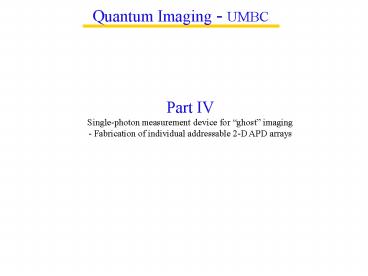Quantum Imaging UMBC - PowerPoint PPT Presentation
1 / 30
Title:
Quantum Imaging UMBC
Description:
Quantum Imaging - UMBC. Part IV. Single-photon measurement device for 'ghost' imaging ... Prof. Ray Hoff, UMBC, NASA JCET Center. Range Finder, and 3-D Lidar ... – PowerPoint PPT presentation
Number of Views:48
Avg rating:3.0/5.0
Title: Quantum Imaging UMBC
1
Quantum Imaging - UMBC
Part IV Single-photon measurement device for
ghost imaging - Fabrication of individual
addressable 2-D APD arrays
2
MOCVD Laboratories
Reactor I
Reactor II
Cleanroom
Cleanroom
3
Reasons To Select APD for Photon Counting
- Possible to achieve large arrays with good
uniformity. - Possible to obtain good photon counting
performance at TE cooler chilled temperatures. - Infrastructure for commercialization exists.
4
Remote Sensing - Imaging Lidar
Prof. Ray Hoff, UMBC, NASA JCET Center
5
Range Finder, and 3-D Lidar (APD Arrays)
Applications
6
Principles of Chemical Detection with Lasers
DIfferential SCattering/DIfferential Absorption
Lidar (DISC/DIAL)
- Rapidly tuned laser emits 2 or more wavelengths
that penetrate cloud - Light is differentially absorbed/scattered upon
transmission as well as reflection - Light reflects off of topographic/aerosol/rain
targets detected at receiver - Agents identified since each has a unique
absorption/scattering spectrum
7
16x16 Arrays
8
64x64 Arrays
9
Key Requirements for Photon Counting (PC)
1. Low Dark Counts Dark current is caused by
surface leakage, tunneling, defects assisted
tunneling. Can be reduced by decrease the
electrical field in the active (absorption)
region. 2. High Gain and High Differential
Gain High gain can be obtained with high bias
voltage. However, with high bias, a high dark
current will also be produced. High differential
gain relies on high rising slope of APD (dG/dV).
An ideal PC APD will have a straight angle I-V
curve, which can be achieved with better device
designs. 3. Designing and Fabricating Materials
with Reduced After-Pulse Dark Current (AFDC)
Amplitude and Duration AFDC comes from traps in
the avalanche regions and trapped carriers in the
hetero-interface. Interstitial Zn atoms created
during the diffusion processes are source of
traps and can be activated and converted to
substitutional dopants by appropriate annealing
procedures. More steps of InGaAsP quaternary
layers (1.1Q, 1.2Q, 1.3Q, 1.5Q, ..etc.) can added
to the InP/InGaAs interface to reduce hole
trapping.
10
Etched-Mesa APD Arrays
11
Etch-Mesa Surface Leakage Current Studies
- With H2SO4 treatment
Annealing with 300C
Polyimide passivation
H2SO4 surface treatment can reduce the surface
leakage current, However, after add in polyimide
passivation the surface leakage current increases.
12
Mesa vs. Guard-Ring
- Mesa structure APDs are the current
state-of-the-art - Potential issues with mesa APDS for space
applications - Short lifetime from early breakdown
- Dark current increases over time
- We are focusing on guard-ring designs to address
the above issues
Mesa
Guard-Ring
13
Reliability of Guard-Ring APDS
Aging test condition 200oC/I100?A Testing
method measure dark current at M10 periodically
S. Tanaka et al on OFC 2003
14
Fabricated Avalanche Photodiode Structure
15
Guard Ring Type High Stability and High
Reliability APDs
16
Optimize Design To Achieve High Differential Gain
and Low Dark Current
Changing the avalanche region thickness, d1, the
charging layer Doping and thickness d2 will
greatly affect the APD characteristics Lower dark
current and high diff gain can be achieved
17
Reducing Tunneling Leakage Current
Reducing the distance between the punch through
voltage and the breakdown voltage will help to
reduce the voltage drop falling on the small
bandgap absorption region
Breakdown field (V/cm) for InP is around 5e5
(handbook series on semiconductor parameters)
and for InGaAs is 2e5.
18
Summary of Calculated Results
19
3 Different APDs at Room Temperature
20
3 Different APDs at 200 Degree K
21
3 Different APDs at 150 Degree K
22
Dark Current I-V Characteristics Changing with
Temperature
- The dark current is reduced
- The gain is increased
- A sharp rising gain with the bias voltage will
help to choose good operating points.
23
4x4 Photon Counting APD Arrays and Their I-V
Characteristics
24
APD Capacitance and Modulation Bandwidth
25
Photon Counting Testing Setup
26
Photon Counting Set Up
27
Photon Counting Operations I
Current Source
28
Photon Counting Pulse Amplitude Statistics
IDC0.005 µA, Vac4.0 V
IDC0.007 µA, Vac4.0 V
29
16x16 Arrays
30
64x64 Arrays































